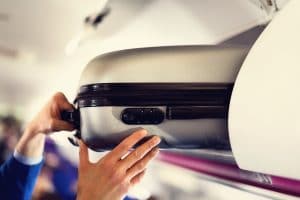
And toting the right type of luggage to fit current-day airline luggage rules will help you avoid extra fees and enable you to comply with carry-on restrictions and check-in weight limits. Figuring out which luggage to buy isn’t easy. To help you arrive at your luggage decision destination, Consumer Reports reviewed a variety of luggage types.
Solving the Case: Luggage Basics
Decide How You’ll Use It
For airplane travel, familiarize yourself with the luggage rules of the airlines you plan to patronize. For cruise ships– which stack baggage in the boat’s belly before departure– flat, rigid luggage is optimal.
Consider How You’ll Store It
Once the luggage gets home, where will you put it? Hard-sided bags are the most unforgiving; you can’t squeeze them into a storage space. Soft-sided, structured bags have a little forgiveness on the front and back, but the footprint is fixed. If you have no place to store a stand-up suitcase, you may have to limit yourself to unstructured duffels or new collapsible bags.
Know Which Size You Need
This will depend mainly on the length of your trip and, if you are flying, airline luggage restrictions. It also depends on your own habits. Some people can pack for two weeks in their carry-on and an under-seat personal item.
Variations on the Valise
Ask yourself this: How many bags do you really need, and what sizes will cover all your needs?
Carry-On Luggage
A carry-on bag is one you can take aboard the airplane and stow in the overhead bin. To avoid being forced to check your suitcase for later retrieval on the conveyor belt, buy a bag that conforms to the strictest rules in the industry.
Currently, for U.S. carriers the rules are the ones set by the big three– American, Delta, and United– at 22 inches high by 14 inches wide by 9 inches deep. (The maximum linear size is 45 inches, but none of the dimensions can exceed the aforementioned measurements.).
Height is the measurement from the floor, including wheels, to the top of the handle in its lowered position. Depth is the measurement from front to back. Width is the measurement from side to side.
Some U.S. carriers permit larger carry-ons. For international flights, defined as those ending and originating outside the U.S.– the size limit is generally smaller than for U.S. domestic flights.
If you are a frequent flyer on different carriers, you’ll have to decide whether you want to buy several carry-on bags to conform to the various size restrictions or if you’ll use one carry-on that meets the most restrictive rules. But even rule-abiding luggage isn’t a guarantee that your bags won’t be relegated to the plane’s underbelly, because the flight crew can impose further restrictions, even after boarding has begun.
Personal Item.
A personal item is a bag that you stow underneath the seat in front of you on a plane. It includes briefcases, tote bags, camera bags, laptop bags, and small backpacks. You can get the most out of your allowed personal item if you buy a bag specifically designed for this purpose.
Often they contain compartments for your passport, wallet, phone, and pen, as well as a padded section for a laptop and the main section for clothes and overnight essentials. Many of these under-seat personal items can serve you well for a one- to two-day jaunt. Paired, the personal item and carry-on can get many people through a weeklong trip.
There is no standard size for the personal item. For U.S. domestic flights the measurement rules range from a generous 18x8x14 inches (Spirit) to a meager 17x9x10 inches (United), and some airlines don’t even specify dimensions.
Whether it fits under the seat can vary even within the same aircraft. Aisle seats are notorious for having the least wiggle room underneath. Before you shop, review the specifications for various airlines. You can also check the aircraft’s guidelines for onboard pet carriers– a reasonable proxy for the floor-to-under seat clearance.
Large Luggage.
Any suitcase larger than carry-on size must be checked. The most common size options are 24 to 30 inches in height. You can find suitcases as large as 36 inches but check with your carrier for size limits. There’s usually a weight limit, with extra fees applied for excess weight per bag. Outside the U.S., restrictions on the total cumulative weight of your checked luggage might apply.
Video Buying Guide.
Watch our video below for top luggage brands and what to do in the store before you purchase new luggage– especially carry-on luggage.
Soft-Sided or Hard-Sided?
Soft-sided luggage continues to dominate the market, but hard-sided is quickly gaining popularity because of newer lightweight materials.
Soft-Sided Luggage.
Soft-sided luggage is made of fabrics that move and yield, usually a woven nylon fabric, such as Cordura or ballistic nylon. Ballistic is the shinier of the two and over time can abrade, but abrasions will not compromise the strength of the fabric. Cordura is a little softer and abrasion-resistant, preferable for an over-the-shoulder bag. If you consider a suitcase made of ripstop nylon, or “parachute material,” make sure that it is a high-denier (pronounced duh-NEER) fabric. Fabric denier is a measurement of weight, not quality.
Pros: Usually lighter in weight and can compress and flex to conform to tight spaces. This flexibility also enables you to squeeze in an extra outfit, (which could be a con if you tend to overpack). Also, a yielding material might be the difference between keeping the bag onboard and having it relegated to gate-check. When packing a car trunk and storing the bag at home, fabric flexibility also comes in handy.
Cons: Not as protective as vulnerable and hard-sided to ripping (accidental or intentional) if not high-quality.
Hard-Sided Luggage.
Today’s hard-shell or hard-sided luggage is made with high-tech plastics such as ABS and polycarbonate, which are both lightweight and durable. ABS is the lightest, but polycarbonate is more durable. The most durable, but also the heaviest, is aluminum. Hard-sided luggage sometimes features a 50/50-split opening, allowing you to pack two sides equally and stabilize the contents with an X-strap or middle divider. Note: Because they close like a clamshell, you need double the surface space to open these. Most hard-sides are built this way, but some on the market have a top-lid opening.
Pros: Best for protecting breakable contents, and offer better security because of integrated locks. They can’t be ripped open with a blade. Most composite plastic hard-sides close with a zipper, which can be vulnerable– aluminum luggage often has metal draw-bolt latches instead of zippers. Hard-sided luggage stacks easily, making it ideal for cruise ships, which stack the baggage in the belly of the boat before departure. If you tend to overpack, a hard-sided piece will rein you in. There’s no chance of overstuffing it. For a carry-on, this guarantees that the piece will fit easily in your airline’s luggage sizer.
Cons: They scuff and scratch easily and are inflexible, so you can’t squeeze in extras, and you need fixed storage space for it. Also, few hard-sided suitcases have outside pockets.
What’s in a Wheel?
Wheeled suitcases make up at least two-thirds of all luggage sales today. Your first decision is whether to buy a two-wheeler or a four-wheeler if you plan on rolling your own luggage.
Two-Wheel Luggage.
Suitcases with two wheels, also called rollers, utilize the same type of wheels found on in-line skates– they roll only forward and backward, not side to side. The suitcase rolls behind you as you pull it from the extending handle.
Pros: Wheels are recessed, which protects them from snapping off during rough handling. For urban journeyers, two-wheelers are better than four-wheelers for rolling and clearing curbs on uneven surfaces such as cobblestones or sidewalks.
Cons: Some travelers complain that the dragging position causes a shoulder, wrist, or back pain. It can be cumbersome to drag a two-wheeler in a crowded space because you need clearance between yourself and the bag. Recessed wheels intrude into the bag’s interior packing area.
Four-Wheel Luggage.
Known as spinners because each wheel swivels 360 degrees, as on a shopping cart. You can push them, pull them, wheel them alongside yourself, and turn them in any direction.
Pros: Easier to navigate in tight spaces. A large or heavy suitcase may be easier to manage with four wheels. Ergonomically, the spinner is a better choice than the roller because it does not put stress on your shoulder.
Cons: Wheels are externally mounted, not recessed, so they are vulnerable to snapping off. (Wheels attached with screws are more secure than those with rivets, according to experts.) Because the length of the wheels is included in the overall allowable dimensions, Spinner wheels also take up valuable overhead-bin space. A spinner won’t remain stationary on an incline; you have to lay it on its side if the floor is on even a slight gradient.
No-Wheel Luggage.
You might want to forgo wheels under these circumstances:
– To ensure the maximum possible interior volume. The wheels and the handle structure use up space.
– You expect to take your bag on bumpy, rough, sandy, or icy surfaces, where wheels are difficult to manage.
– You won’t have to ever handle your own luggage, as on a luxury tour.
Time to Upgrade? Some Shopping Tips.
Take a Tape Measure.
There’s no regulation that dictates carry-on size– airlines impose their own restrictions, and the limits can vary among airlines and even among aircraft. Measure the dimensions yourself and make sure the measurements account for all parts, including outer pouches, wheels, and handles.
Hold That Handle.
Check the wrist angle and the feel of the grip. For maximum durability, the handle should have little to no wiggling or rattling as you pull the bag. Also, check for smooth movement as you pull it up and retract it.
Wheel It Around.
The wheels should roll smoothly and stay in place. Gently jiggle the wheels with your hands to make sure they are firmly attached.
Check the Interior Capacity.
The outside measurements are important but don’t forget to consider how roomy the inside is. Look for the features that maximize interior space.
– Squared edges: Interior volume is sacrificed with curved corners.
– Integrated outer compartments: Outside zip compartments should be on the same geometric plane as the main part of the bag– protrusions waste space.
– No wheels or handles: If you really need to make the most of every interior inch, forgo wheels and handles. They impinge on total packable space.
Check the Warranty.
If you want your bag for the long haul, get the one with the best manufacturer’s warranty. A lifetime warranty to replace the bag or repair is, of course, the best option. Some examples of manufacturers offering the best warranties include:
– Briggs & Riley.
– Boyt (on some product lines only).
– Eagle Creek (some product lines).
– eBags (house brand).
– Lands’ End.
– L.L.Bean.
– Osprey.
– Travelpro (Platinum 7 Collection).
– Victorinox (some collections).
Always make sure to check the warranty statement for specific requirements, such as exclusions for airline damage.
Shopping Online.
If you don’t shop for luggage often and stumble across an online deal, try to find the item in a walk-in store first so that you can handle it, wheel it, and lift it to make sure the bag is suitable for you.
Choosing the best and suitable luggage is fun and exciting. Below is a video which you may find helpful for you.
Related Topics:
Pros and Cons of the Best Multicookers
How To Find The Best Physical Fitness Tracker










